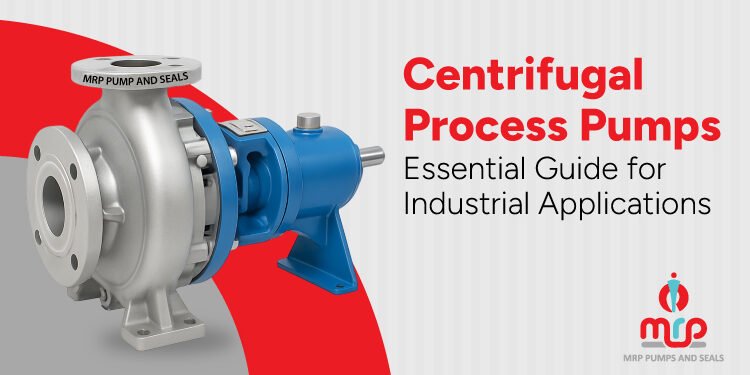In the heart of every industrial facility, fluid management systems work tirelessly to keep operations running smoothly. Among these centrifugal process pumps stand out as workhorses that power countless applications across manufacturing sectors worldwide.
Whether you’re handling chemicals in a pharmaceutical plant, managing slurries in mineral processing, or maintaining cooling systems in a food production facility, centrifugal process pumps are likely to form the backbone of your fluid transfer operations.
This comprehensive guide explores everything you need to know about these versatile pumps – from basic operating principles to advanced selection criteria, maintenance best practices, and emerging applications, including their growing relevance in supporting infrastructure for telemedicine and remote healthcare facilities.
What is a Centrifugal Process Pump?
The Core Concept
A centrifugal process pump is a dynamic pump that uses rotational energy from an impeller to increase the pressure and flow rate of liquids. Unlike positive displacement pumps that trap and force fluid, centrifugal pumps impart velocity to the fluid using centrifugal force.
When the impeller rotates, it creates a low-pressure area at the inlet (eye) of the pump, drawing fluid in. The fluid then gains velocity as it moves through the impeller and is discharged at the pump outlet at higher pressure.
This elegant mechanical principle makes centrifugal pumps ideal for applications requiring consistent flow rates across varying system pressures.
Key Components
A typical centrifugal process pump consists of several critical components:
- Impeller: The rotating component that imparts energy to the fluid
- Casing: Contains the fluid and directs it from the inlet to the outlet
- Shaft: Connects the impeller to the motor
- Bearings: Support the shaft and reduce friction
- Seals: Prevent leakage where the shaft enters the casing
- Wear Rings: Minimize internal recirculation and maintain efficiency
- Motor: Provides the driving force for the impeller
Where Centrifugal Process Pumps Fit in Industrial Operations
In the industrial ecosystem, centrifugal process pumps serve as the primary means of liquid transfer in processes requiring:
- Medium to high flow rates
- Relatively low to medium pressure requirements
- Continuous operation
- Handling of thin to moderately viscous fluids
- Reliable performance with minimal maintenance
These pumps form the circulatory system of industrial operations, moving everything from water and chemicals to oils, solvents, and slurries through production processes.
Why Are Centrifugal Process Pumps Used in Industries?
1. Superior Efficiency and Flow Capacity
Centrifugal pumps excel in applications requiring high flow rates with moderate pressure requirements. Their design allows for continuous, pulsation-free flow that many industrial processes demand.
For operations running 24/7, the energy efficiency of these pumps translates to significant cost savings. Modern centrifugal pumps can achieve efficiency ratings of 60-85%, depending on the specific design and application.
2. Versatility in Handling Different Fluids
One of the greatest strengths of centrifugal process pumps is their ability to handle various types of fluids:
- Clean water and other low-viscosity liquids
- Chemicals with corrosive properties (with appropriate material selection)
- Slurries with moderate solid content
- High-temperature fluids
- Volatile and flammable liquids
This versatility makes them indispensable across diverse industries, from water treatment to chemical processing.
3. Comparative Advantages Over Other Pump Types
When compared to positive displacement pumps, centrifugal pumps offer:
| Feature | Centrifugal Pumps | Positive Displacement Pumps |
| Flow Consistency | Smooth, non-pulsating flow | Pulsating flow |
| Pressure Variation | Flow varies with pressure changes | Constant flow regardless of pressure |
| Handling Solids | Limited solid-handling capability | Better with high-viscosity fluids |
| Initial Cost | Generally lower | Typically higher |
| Maintenance | Simpler maintenance requirements | More complex maintenance |
| Space Requirements | Compact footprint | Often larger and more complex |
| Efficiency with Thin Fluids | Excellent | Less efficient |
This comparison shows why centrifugal pumps dominate in applications involving lower-viscosity fluids and continuous operation.
Major Applications Across Industries
1. Chemical Industry
In chemical processing, centrifugal process pumps handle a wide range of fluids, from acids and bases to solvents and intermediates. Their ability to transfer corrosive liquids makes them essential in:
- Batch reactors circulation
- Transfer between storage tanks
- Feeding filtration systems
- Chemical blending operations
- Waste treatment processes
Material selection becomes critical in this sector, with options including stainless steel, alloy 20, Hastelloy, titanium, and various polymer linings to handle aggressive chemicals.
2. Oil & Gas Applications
The petroleum industry relies heavily on centrifugal pumps for:
- Crude oil transfer
- Refinery processes
- Pipeline operations
- Cooling water circulation
- Product loading/unloading
These applications often require pumps certified to API 610 standards, with special considerations for high pressures, temperatures, and potentially explosive environments.
3. Pharmaceutical Production
The pharmaceutical industry demands pumps that meet stringent hygiene standards. Centrifugal process pumps in this sector are typically:
- Constructed from 316L stainless steel or higher-grade materials
- Designed with polished surfaces (Ra < 0.5μm)
- Free of dead spots where product could accumulate
- Easy to clean-in-place (CIP) or sterilize-in-place (SIP)
Common applications include fermentation processes, filtration, purified water systems, and WFI (Water for Injection) circulation.
4. Water and Wastewater Treatment
Municipal and industrial water treatment relies on centrifugal pumps for:
- Raw water intake
- Chemical dosing
- Filter feed
- Backwash operations
- Sludge transfer
- Final distribution
These applications typically prioritize reliability and efficiency, as pumps often run continuously for years with minimal downtime.
5. Emerging Use in Telemedicine Infrastructure
An interesting development is the growing use of specialized centrifugal pumps in telemedicine and remote healthcare facilities. These applications include:
- Cooling systems for diagnostic equipment
- Temperature control for sensitive medications
- Circulation in sterilization equipment
- Vacuum systems for medical procedures
- Water purification for laboratory operations
As telemedicine expands, reliable pump systems become increasingly important for maintaining the infrastructure that enables remote healthcare delivery.
Types of Centrifugal Process Pumps
At MRP Pumps & Seals, we offer a comprehensive range of centrifugal pumps and related products designed to meet the diverse needs of various industries. Each pump type is engineered for specific operating conditions and applications.
General Purpose Centrifugal Pumps
| Pump Type | Key Features | Best Applications | Industries Served |
| Centrifugal Process Pumps | High efficiency, robust construction, various material options | Chemical transfer, industrial processing | Chemical, Pharmaceutical, Oil & Gas |
| Centrifugal End Suction Pumps | Excellent accessibility, easy maintenance | Water supply, irrigation, general transfer | Textile, Paper, Water Treatment |
| Centrifugal Monoblock Pumps | Compact integrated design, no alignment issues | General fluid transfer, irrigation | Agriculture, Building Services |
| Close Coupled Centrifugal Pumps | Space-saving design, reduced maintenance | HVAC, industrial cooling, water distribution | Manufacturing, Commercial Buildings |
| Horizontal Single Stage Side Suction Pumps | Reliable operation, good efficiency | General industrial applications | Manufacturing, Textiles, Sugar |
Specialized Centrifugal Pumps
| Pump Type | Key Features | Best Applications | Industries Served |
| High Flow Low Head / Mix Flow Pumps | Large volume handling at lower pressures | Flood control, irrigation, cooling systems | Municipal, Agriculture, Power Generation |
| Slurry Pumps | Abrasion-resistant materials, designed for solids | Mining slurries, mineral processing | Mining, Steel, Cement |
| Sewage Mud Pumps | Non-clog design, solids handling capability | Wastewater, sewage transfer | Municipal, Food Processing |
| Vertical Long Shaft Sump Pumps | Extended length for deep sumps, minimal footprint | Drainage, effluent handling | Construction, Mining |
| Polypropylene Centrifugal Pumps | Corrosion-resistant construction | Aggressive chemicals, acids | Chemical, Textile, Plating |
| Vertical Inline Centrifugal Pumps | Space-saving design, easier piping | HVAC, booster applications | Commercial Buildings, Manufacturing |
| Vertical Seal / Glandless Pumps | Zero leakage, environmentally safe | Hazardous fluids, valuable liquids | Chemical, Pharmaceutical |
High-Pressure Pump Solutions
| Pump Type | Key Features | Best Applications | Industries Served |
| High Pressure Multistage Pumps | Multiple impellers in series, high pressure generation | Boiler feed, high-rise buildings | Power Plants, Building Services |
| High Pressure Triplex Plunger Pumps | Very high-pressure capability | Hydro-testing, cleaning systems | Oil & Gas, Manufacturing |
| Metering Plunger Pumps | Precise flow control | Chemical dosing, injection | Water Treatment, Chemical |
| Motorized Hydraulic Test Pumps | Controlled pressure for testing | Pipeline testing, pressure vessel testing | Oil & Gas, Manufacturing |
| Metering Dosing System (Plunger & Diaphragm) | Accurate chemical addition | Water treatment, process control | Pharmaceutical, Food & Beverage |
Thermal Management Pumps
| Pump Type | Key Features | Best Applications | Industries Served |
| Air Cooled Pumps | External cooling for heated applications | Hot fluid handling | Chemical, Manufacturing |
| Thermal Hot Oil / Water Cooled Pumps | Designed for high temperature fluids | Heat transfer systems | Textile, Chemical, Food Processing |
Vacuum & Special Purpose Pumps
| Pump Type | Key Features | Best Applications | Industries Served |
| Single Stage Liquid Ring Vacuum Pumps | Moderate vacuum, simple operation | Process vacuum, deaeration | Pharmaceutical, Food & Beverage |
| Two Stage Liquid Ring Vacuum Pumps | Higher vacuum capability | Filtration, distillation | Chemical, Paper & Pulp |
| Multi-Purpose Rotary Gear Pumps | Positive displacement, good for viscous fluids | Oil transfer, viscous products | Food Processing, Chemical |
| Progressive Cavity Screw Pumps | Handles high viscosity, low shear | Viscous fluid transfer, slurries | Food & Beverage, Wastewater |
Our comprehensive portfolio includes spare parts and accessories to ensure optimal performance and longevity of your pumping systems.
Choosing the Right Pump for Your Industry
Selecting the optimal centrifugal process pump involves evaluating several key parameters specific to your application.
Critical Selection Parameters
1. Flow Rate Requirements
The volume of fluid that needs to be moved per unit time is typically expressed in:
- Gallons per minute (GPM)
- Cubic meters per hour (m³/h)
- Liters per minute (LPM)
Accurately determining flow requirements prevents oversizing (wasting energy) or undersizing (inadequate performance).
2. Total Dynamic Head (TDH)
TDH represents the total resistance the pump must overcome, including:
- Static head (elevation differences)
- Friction losses in piping
- Pressure head requirements of the process
Expressed in feet or meters of head (or sometimes PSI/bar), this parameter is crucial for proper pump sizing.
3. Fluid Properties
Consider these characteristics of your process fluid:
- Viscosity (affects efficiency and power requirements)
- Temperature (impacts material selection and clearances)
- Corrosiveness (determines construction materials)
- Solid content (influences impeller type)
- Specific gravity (affects power requirements)
4. Environmental Factors
- Ambient temperature
- Area classification (general purpose or hazardous)
- Indoor vs. outdoor installation
- Space constraints
- Noise limitations
Decision Matrix for Pump Selection
Use this simplified decision matrix as a starting point:
| Parameter | Low Range | Medium Range | High Range | Recommended Pump Type |
| Flow Rate | <100 GPM | 100-1000 GPM | >1000 GPM | Small volute → Large axial flow |
| Head | <50 ft | 50-500 ft | >500 ft | Single stage → Multistage |
| Viscosity | <100 cP | 100-500 cP | >500 cP | Standard → Special design → Consider PD pump |
| Temperature | <180°F | 180-400°F | >400°F | Standard → Cooling → Special high temp |
| Solids | None | Small/Soft | Large/Abrasive | Closed → Semi-open → Vortex/Slurry |
| Corrosiveness | Non-corrosive | Mildly corrosive | Highly corrosive | Cast iron → SS → Alloy/Lined |
Industry-Specific Considerations
1. Chemical Industry Checklist
- Chemical compatibility with pump materials
- Secondary containment requirements
- CIP/SIP capabilities if needed
- ATEX/explosion-proof requirements
- Chemical seal plans per API 682
2. Food and Beverage Requirements
- Sanitary design standards (3A, EHEDG)
- Surface finish requirements
- Cleanability
- FDA-compliant materials
- Drainability
3. Oil & Gas Specifications
- API 610 compliance
- NACE material requirements
- Seal plans for volatile fluids
- Winterization for outdoor installations
- Spare parts strategy for critical service
Common Challenges and How to Avoid Them
Understanding common operational issues with centrifugal pumps can help prevent costly downtime and repairs.
1. Cavitation: The Silent Destroyer
Cavitation occurs when the pressure at the pump inlet falls below the vapor pressure of the liquid, causing bubbles to form and then implode against the impeller.
Signs of cavitation:
- Noise that sounds like marbles or gravel in the pump
- Vibration and unstable flow
- Reduced performance
- Pitting damage to impeller and casing over time
Prevention strategies:
- Ensure adequate NPSH available in system design
- Properly size suction piping (typically one size larger than discharge)
- Install pump below supply level when possible
- Use low-speed pumps for problematic applications
- Install suction stabilizers if needed
2. Seal Failure Issues
Mechanical seals are often the first component to fail in centrifugal pumps.
Common causes:
- Dry running
- Misalignment
- Improper installation
- Incompatible seal materials
- Abrasive particles in fluid
Best practices:
- Install appropriate seal flush plans
- Use dual seals for critical applications
- Monitor seal chamber temperature
- Implement proper startup procedures
- Consider seal-less designs for problematic fluids
3. Improper Priming Challenges
Centrifugal pumps must be fully primed (filled with liquid) before startup to function properly.
Issues caused by improper priming:
- Inability to build pressure
- Overheating
- Excessive wear on seals and bearings
- Potential cavitation damage
Solutions:
- Install foot valves for suction lift applications
- Use automatic priming systems
- Implement proper venting procedures
- Consider self-priming pump designs
- Train operators on proper startup sequences
4. Preventative Maintenance Checklist
Implement these routine checks to maximize pump life and minimize failures:
Daily/Weekly:
- Monitor discharge pressure and flow
- Check for unusual noise or vibration
- Inspect for leaks
- Verify proper bearing temperature
Monthly:
- Check coupling alignment
- Inspect foundation bolts for tightness
- Test lubricant quality
- Verify proper seal flush flow
Annually:
- Measure and record impeller clearances
- Check wear ring clearances
- Complete vibration analysis
- Perform performance test to detect efficiency decline
- Inspect internal components
When to Choose Centrifugal Process Pumps
Centrifugal pumps are the optimal choice when:
- Flow requirements exceed pressure requirements Centrifugal pumps excel in moving large volumes at moderate pressures.
- The fluid has low to moderate viscosity. These pumps work best with thin fluids below 500 cP.
- Continuous, steady flow is needed. The non-pulsating nature of centrifugal flow is ideal for many processes.
- Space and weight are concerns Their compact design and favorable power-to-weight ratio make them efficient choices.
- Initial cost is a primary consideration Centrifugal pumps typically have lower upfront costs than comparable positive displacement pumps.
- Minimal maintenance is desired with fewer worn parts; they generally require less frequent service.
Maintenance & Lifecycle Tips
Proper maintenance is key to maximizing pump efficiency and service life.
Essential Maintenance Practices
1. Operation & Monitoring
- Operate near the best efficiency point to minimize wear
- Monitor vibration, noise, and temperature changes
- Ensure proper alignment to prevent premature failures
- Perform regular efficiency testing
2. Energy Efficiency
- Right-size pump selection (avoid oversizing)
- Consider VFDs for variable demand applications
- Maintain internal clearances with timely wear ring replacement
3. Spare Parts & Support
- Keep critical spares on hand (seals, bearings, gaskets)
- Choose quality parts appropriate to application criticality
- Document maintenance history for troubleshooting
Contact MRP Pumps & Seals for comprehensive maintenance support and expert advice on optimizing your pumping systems.
Conclusion
Centrifugal process pumps remain the workhorses of industrial fluid handling, providing reliable and efficient liquid transfer across countless applications. Their versatility, simple maintenance, and favorable economics make them the dominant choice for most industrial processes.
As a leading industrial pump manufacturer in India, MRP Pumps combines over 15 years of expertise with exceptional engineering to deliver centrifugal pumps that stand the test of time. Our comprehensive range meets diverse industry requirements with optimal performance and reliability.
Ready to enhance your operations with expert pump solutions? Our team is just a call away.
Frequently Asked Questions
With proper maintenance, industrial centrifugal pumps typically last 15-20 years. Lifespan varies based on operating conditions, fluid properties, and maintenance practices.
Listen for a distinctive noise like marbles passing through the pump, accompanied by erratic readings, increased vibration, and reduced performance. Address suction issues immediately to prevent damage.
Centrifugal pumps work best with fluids below 200-300 cP. For higher viscosities, consider specially designed pumps, reduced speeds, or alternative pump technologies like our Progressive Cavity or Rotary Gear pumps.
Proper pump selection can significantly reduce energy consumption. An optimally sized pump operating near its efficiency point can save 20-25% in energy costs compared to an oversized or misapplied pump.
Regular alignment checks, maintaining proper clearances, and addressing small issues before they escalate offer the biggest ROI. Preventive maintenance costs far less than emergency repairs or premature replacement.





